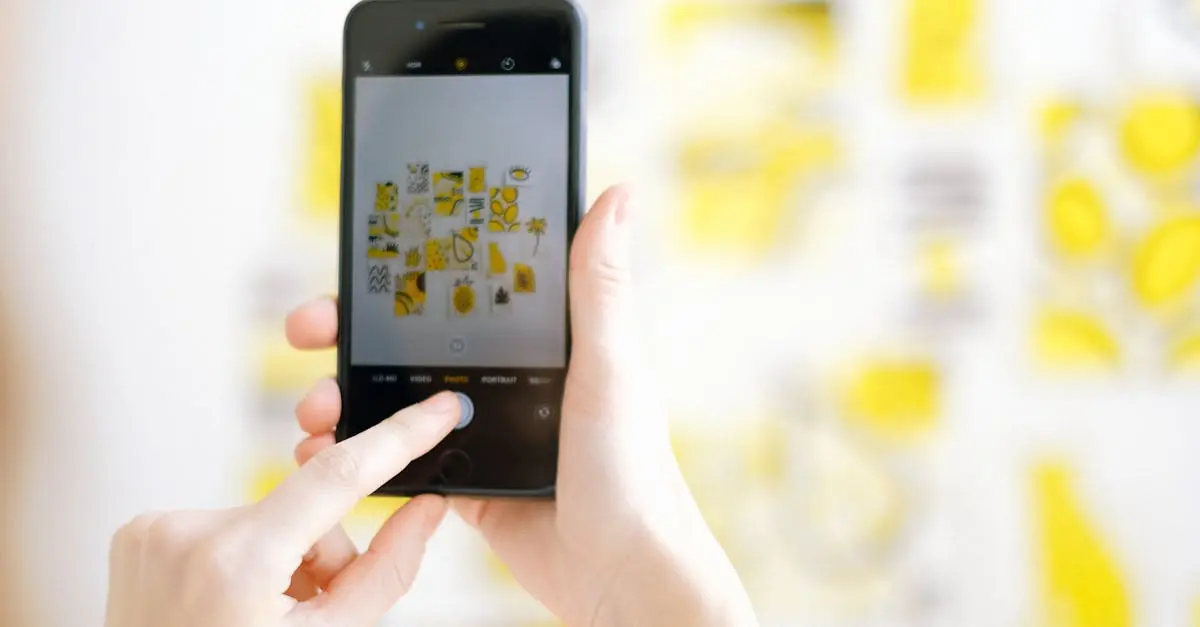Ever sent a stunning photo from your iPhone to a friend with an Android, only to be met with a blurry mess? It’s like sending a gourmet meal and getting back a soggy sandwich. Frustrating, right? This common issue has left many scratching their heads and wondering if their smartphone is playing a cruel joke.
The truth is, the tech behind these devices doesn’t always play nice. Different operating systems and compression methods can turn your high-resolution masterpiece into a pixelated puzzle. But fear not! Understanding why this happens can help bridge the gap between iPhone and Android users, ensuring that every snapshot shines as bright as intended. So, let’s dive into the blurry world of cross-platform photo sharing and uncover the secrets behind those less-than-perfect images.
Table of Contents
ToggleUnderstanding Image Quality
Image quality often diminishes when transferring photos from an iPhone to an Android device. Different technologies and standards contribute to this phenomenon.
Factors Affecting Image Clarity
Compatibility issues arise primarily due to different operating systems. Variations in display resolution and screen technology between devices also impact clarity. Network conditions can further complicate matters, as unstable connections may lead to additional degradation of images. Users may also experience this issue during sharing via messaging apps, which can impose restrictions on image quality. Lighting conditions and the original photo’s resolution determine the inherent clarity of the picture. These factors combined can create significant differences in how images appear once transferred.
Compression Techniques Used
Compression techniques play a crucial role in image quality loss. When an image is sent, both iPhone and Android devices apply varying levels of compression to files. This compression helps reduce file size but often sacrifices clarity in the process. iPhones utilize HEIF (High Efficiency Image Format), while Android devices commonly default to JPEG. Differences in algorithms further exacerbate the issue, as each system processes image data uniquely. Sending images through various messaging platforms often requires additional compression, leading to blurry results. Understanding these techniques can help users choose better methods for sharing photos.
iPhone to Android Transfer Process
Sending images from an iPhone to an Android device involves several technical steps that affect quality. Each device employs different protocols, which can lead to significant variations in how images appear once transferred.
How Images Are Sent Between Devices
Images are typically sent via messaging protocols like MMS or through third-party apps. When an iPhone user sends a photo, the image often undergoes compression to minimize file size. Compression methods vary between devices, making compatibility crucial. iPhones use HEIF for efficient storage, while Android devices often rely on JPEG. The shift in formats causes discrepancies during transfer, often leading to blurriness in the received image due to degradation in quality.
Impact of Messaging Apps on Quality
Messaging apps play a notable role in image quality during transfers. Certain applications impose strict size restrictions, which can force further compression on images. For instance, WhatsApp compresses photos significantly to speed up transfers, affecting clarity. Users can frequently find that photos sent through these platforms appear soft or pixelated. Directly sharing via email or cloud services often retains superior quality, making these alternatives preferable for important images. Choosing the right platform helps minimize the negative impact on photo clarity.
Common Issues with Blurry Images
Blurry images often stem from technical issues during the transfer process. Understanding these challenges can help mitigate frustration.
Reasons for Blur in Transferred Photos
Compression techniques play a significant role in reducing image quality. iPhones typically use HEIF format, while Android devices often default to JPEG. Each format applies distinct compression algorithms. Lossy compression can lead to soft or pixelated images. Additionally, messaging apps impose strict file size limits, further degrading photo clarity. Network conditions also impact image quality. Poor connectivity can interrupt data transmission, resulting in lower-resolution images. Overall, the combination of format differences, compression methods, and network issues causes the blurriness users frequently encounter.
User Experiences and Feedback
Many users express frustration when sending images across platforms. They notice significant quality losses, especially when using popular messaging apps. Complaints frequently highlight how images sent from iPhones appear blurry on Android devices. Feedback indicates that users feel their original photo quality diminishes drastically during transfers. Other users report that sharing images via email or cloud services preserves clarity better than instant messaging. Observations indicate that understanding these factors has helped users adapt their sharing methods. An increase in awareness leads to improved user satisfaction with image quality when communicating across different systems.
Tips to Improve Image Quality
Improving image quality during transfers from iPhone to Android involves applying effective practices and utilizing the right applications.
Best Practices for Sending Photos
Choose the right format for sharing photos. HEIF files work well for iPhones, but converting them to JPEG can enhance compatibility. Always check the resolution of the images before sending. Higher resolutions maintain quality better, regardless of the recipient’s device. Avoid using social media platforms for direct transfers; they often apply heavy compression. Instead, consider email, which typically preserves image clarity. When utilizing messaging apps, select options that prioritize quality over speed. Lastly, ensure a stable network connection during file transfers; poor connections frequently lead to additional degradation.
Recommended Apps for High-Quality Transfers
Utilize cloud storage platforms like Google Drive or Dropbox for transferring images. These services maintain the original quality without applying unnecessary compression. Explore messaging apps that emphasize high-resolution transfers, such as Signal or Telegram. Both of these offer superior quality options compared to others. Consider using AirDrop if both devices are within proximity; direct transfers avoid compression entirely. Also, email platforms like Gmail often allow for sending large attachments, preserving clarity in transition. Select apps based on user reviews about image quality; other users’ experiences can provide valuable insights.
Understanding why images sent from iPhones to Android devices often appear blurry is crucial for enhancing photo sharing experiences. The differences in operating systems and compression methods can lead to significant quality loss. By being aware of these technical challenges users can take steps to ensure their images retain clarity.
Utilizing alternative sharing methods like cloud services or specific messaging apps designed for high-resolution transfers can make a noticeable difference. Adopting best practices in photo sharing will not only reduce frustration but also improve overall satisfaction with cross-platform communication. With the right approach users can enjoy clearer images regardless of the device they’re using.



